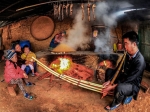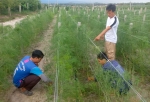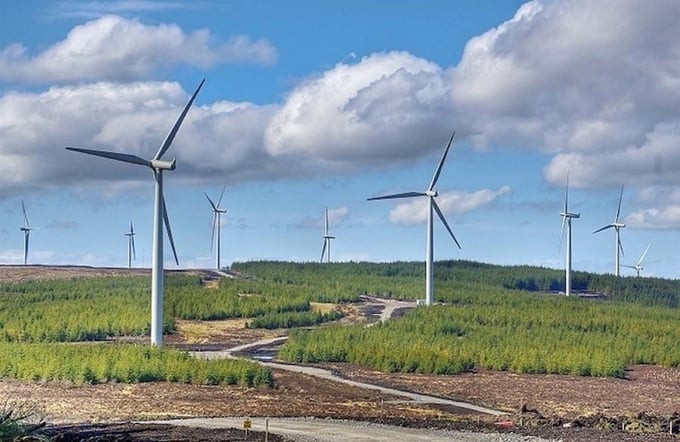Cross the mountains to find the last Keteleeria davidiana
Following in the footsteps of indigenous people in the buffer zone of Kim Hy Nature Reserve (Bac Kan), we set out to find the last remaining Keteleeria davidiana on the rolling limestone mountains. Tham Mu village is right next to the core area of the Reserve, this is also the starting point of our journey. Tham Mu village head, Mr. Ban Van Quoc led the way, accompanied by 2 veteran forest rangers who have been attached to Kim Hy mountains and forests for many years.
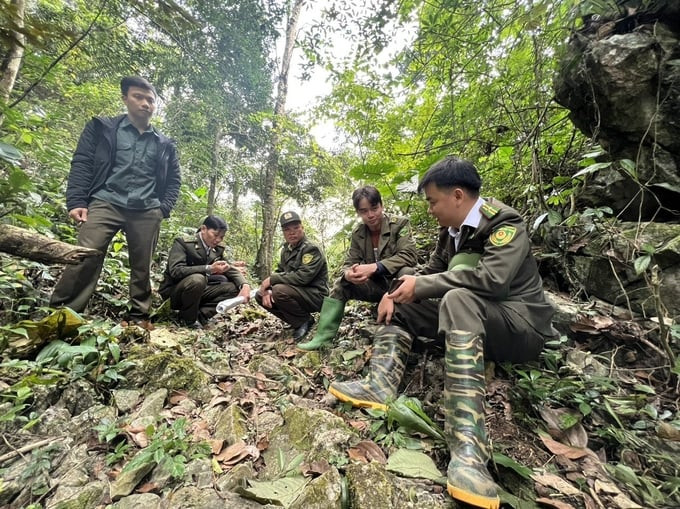
Forest ranger of Kim Hy Nature Reserve on the journey to find the last limestone Keteleeria davidiana
As he walked, Mr. Quoc shared: Keteleeria davidiana only grows on jagged, rocky mountain peaks that are foggy and windy all year round. This tree has strong vitality, and because of that, the wood of this tree is very precious, and that alone also makes it a prime target for loggers.
More than 15 years ago, the number of Keteleeria davidiana was still quite large, but at that time loggers brought blankets and cloaks into the deep forest to sleep, waiting to cut them down, so the number decreased rapidly. Up to now, the forest is better protected, but the remaining Keteleeria davidiana can be counted on a hand.
After nearly two hours of overcoming the craggy rocky mountains, covered in fog all year round, the Keteleeria davidiana also appeared. Before our eyes, the Keteleeria davidiana grew halfway up the rocky mountainside with a diameter of more than 80cm and about 20m high. The easily recognizable feature is that the Keteleeria davidiana has leaves like pine leaves, so the indigenous people call it the stone pine tree. The wood of this tree has very beautiful grain and a faint scent, so it is very popular among wood enthusiasts to use it to make luxury furniture.
Forest rangers here said that after many years of collecting information, it was determined that there are only about 3 ancient Keteleeria davidiana left in Kim Hy Nature Reserve. The last Keteleeria davidiana on the top of Kim Hy rocky mountain are all in difficult-to-reach craggy positions, and this characteristic has helped them survive until now in the face of the greed of loggers.
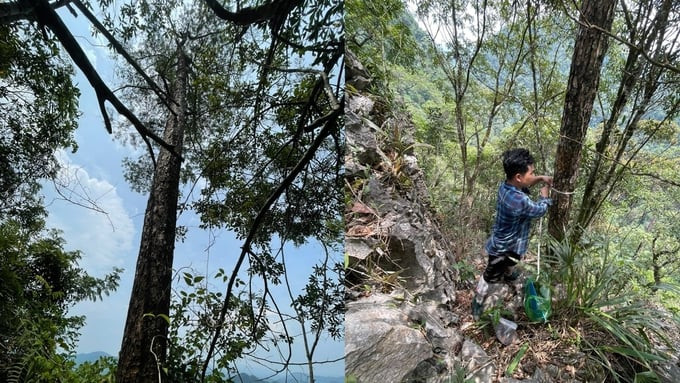
One of the rare Keteleeria davidiana trees remains on the top of Kim Hy mountain
According to research documents from 2000 - 2004, on the mountain peaks in the Kim Hy area, there are more than 100 mature Keteleeria davidiana individuals. But by 2008, there were only 7 individuals left in the whole area, growing scattered on relatively rugged rocky peaks over 800m above sea level. These 7 Keteleeria davidiana trees are distributed relatively concentrated on the mountain tops in the centre of Kim Hy Nature Reserve. By 2009, during additional investigation, researchers discovered that 2 individuals had been cut down, leaving only 5 surviving trees. During the survey, the research team also found one more fully grown Keteleeria davidiana individual on the top of Khuy Ta mountain.
Mr. Le Xuan Dieu, in charge of the Management Board and head of the Forest Ranger Department of Kim Hy Nature Reserve, said that the latest survey shows that, there are currently only 3 ancient Keteleeria davidiana left in the Conservation Area, the risk of this tree becoming extinct is looming.
Successful seed breeding in the past
Faced with the risk that the Keteleeria davidiana may disappear, a number of solutions have been implemented. About 10 years ago, Kim Hy Nature Reserve in collaboration with scientists organized the collection of seeds from ancient trees for nursery purposes. After a period of time, about 1 thousand seedlings were successfully nursed.
When the seedlings grow well, the Conservation Area has selected a number of areas with the habitat this species likes to live in and the most suitable climate for planting. This favourable start seemed to have saved the Du Sam species from extinction, but to date, all the planted trees have died.
Forest rangers who directly planted and inspected said that when first planted, some trees grew quite well, but after a while the trees died for unknown reasons. Since then, Kim Hy Nature Reserve has mainly protected naturally growing ancient trees. There have been no additional projects to preserve and develop this rare tree species.
Kim Hy Nature Reserve has a total area of more than 15,000 ha, of which the strictly protected area is nearly 11,000 ha. The ecological restoration zone is about 3,000 ha, the remaining is the administrative area and buffer zone. This conservation area stretches across 7 communes in the Na Ri and Bach Thong districts of Bac Kan province.
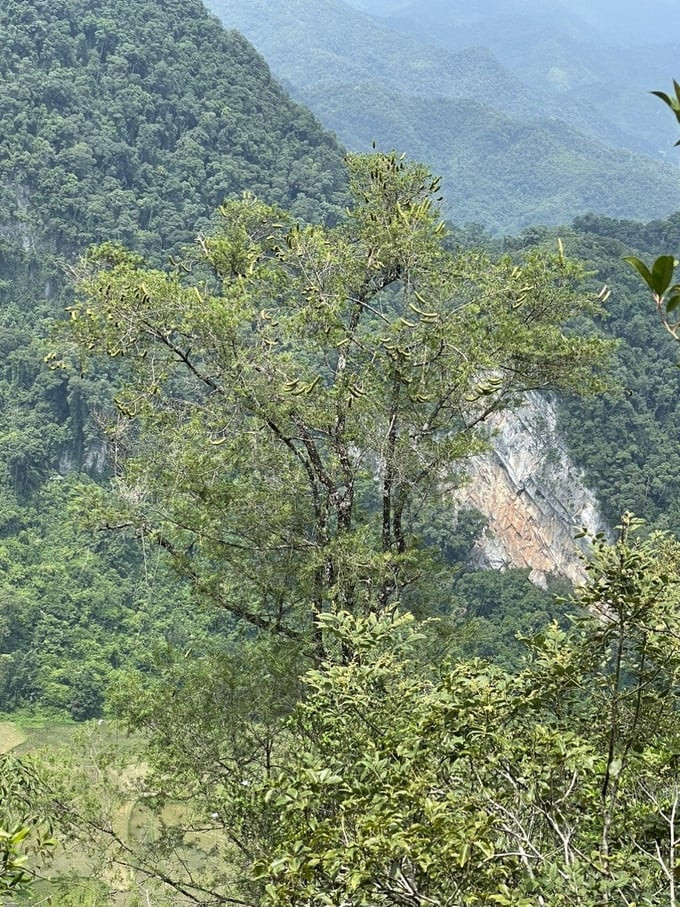
The natural regeneration of the Keteleeria davidiana species is very poor, so there are very few individuals left
M.S. Ngo Duc Nhac, Northeast Forest Science Center (Vietnam Forest Science Institute) said, that since 2021, the Center has implemented the project "Research on conservation and development of genetic resources of Keteleeria davidiana trees in some northern mountainous provinces".
Through initial surveys in Kim Hy Nature Reserve, based on an assessment of small population size, with a narrow distribution in two locations close to each other, it can be assessed that the risk of extinction of this tree species is very high. On the other hand, the natural regeneration of this species is very poor, leading to the risk of extinction and loss of valuable genetic resources.
Therefore, the most urgent task at this time is to investigate forestry characteristics and evaluate the value of genetic resources and genetic diversity to have complete and systematic information to preserve and develop Keteleeria davidiana in Bac Kan province.
“In the immediate future, it is necessary to have breeding measures, specifically using sexual propagation techniques to provide enough seed sources for afforestation. Build models for planting, caring for and instructing breeding techniques and planting techniques for Keteleeria davidiana, only then can this tree species avoid the risk of extinction", said M.S. Ngo Duc Nhac.
Translated by Hoang Duy




